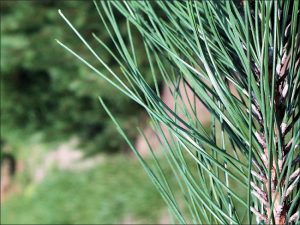Norway Pine (Red Pine)
Norway pine also called red pine is a species of medium-sized, evergreen coniferous trees found in North America. Growing in pure, hardwood, or mixed-conifer stands, the Norway pine commonly occurs with Virginia pine, Table Mountain pine, pitch pine, and eastern white pine. It has a conical crown that becomes rounded dome at maturity.
Scientific Classification
| Kingdom | Plantae |
| Division | Pinophyta |
| Class | Pinopsida |
| Order | Pinales |
| Family | Pinaceae |
| Genus | Pinus |
| Subgenus | Pinus |
| Scientific Name | Pinus resinosa |
Quick Information
| Other Names | Northern pine, Pin rouge (French) |
| Size | Height: 66-115 ft (20-35 m); can reach 143 ft (43.7 m)
Trunk Diameter: 3 ft 3 in (1 m) |
| Identification | Leaves (Needles): Dark yellow-green, two needles in each fascicle, snap when bent, 12-18 cm long
Cones: Symmetrical ovoid, purple when young, ripen to nut-blue, 4-6 cm long, 2.5 broad Bark: Thick, grayish-brown base; thin, bright-orange, flaky upper crown in young trees; become plated with age |
| Distribution/Range | From eastern North America and Newfoundland west to Minnesota, Manitoba; also in the Appalachian Mountains, West Virginia, northern New Jersey, central Illinois |
| Hardiness Zones | 3-6 |
| Growth Rate | Slow to medium; 1-1.5 ft per year |
| Lifespan | Long-lived tree, can survive up to 500 years |
| Growing Conditions | Winter Conditions: Cold winters with average temperatures ranging between -18° and -4° C
Summer Conditions: Cool to warm; average temperatures range from 16-20° C Rain: 510-1,010 mm per year Sunlight: Full sun Soil Requirements: Sandy loam, moist, well-drained, acidic; sometimes grow in rocky and dry soil |
| Diseases and Pests | Shoestring root rot, Scleroderris canker, Fomes root rot; insects like pine shoot beetle, jack pine budworm, white pine weevil, European pine shoot moth, and pine root-collar weevil cause damage |
| Flowering/Fruiting | Flowers appear during April-June; pollination takes place during May-June, fertilization occurs in mid-July the following year |
| Breeding System | Monoecious |
| Seed Production | Starts at 15-25 years of age, best produced from 50-150 years |
| Seedling Development | Seedlings emerge in moderate conditions, with the temperature ranging from 21°-30° C and rainfall greater than 100 mm during the growing season |
| Wildlife Value | Provide habitat and nesting sites for pine warbler, osprey, bald eagle, and great blue heron; white-tailed deer and snowshoe hares browse the shoots and seedlings; squirrels, meadow voles, and white-footed mice consume the seeds |
| Varieties/Cultivars | ‘Don Smith,’ ‘Morel,’ ‘Globosa,’ ‘Fastigiata,’ ‘Aurea,’ ‘Baxter,’ etc. |
| Uses | For wood production including poles, piling, cabin logs, lumber, posts, pulpwood, mine timbers, railway ties, box boards, and fuel; as a bonsai, ornamental, and Christmas tree; for sandblow control, windbreaks, and snowbreaks |
| IUCN Conservation Status | Least Concern |
Interesting Facts
- Since Norway pine is a self-pruning tree, dead branches are rarely visible on it.
- In 1953, red pine was recognized as the state tree of Minnesota.
References:











